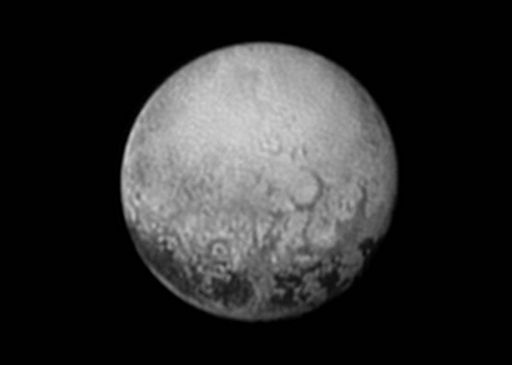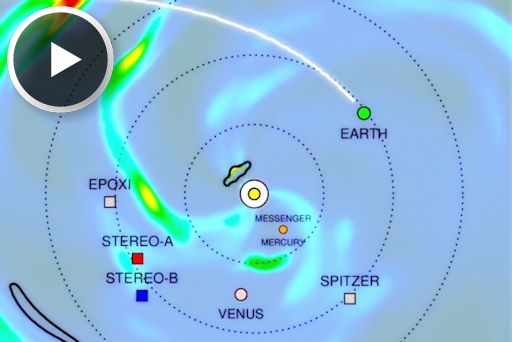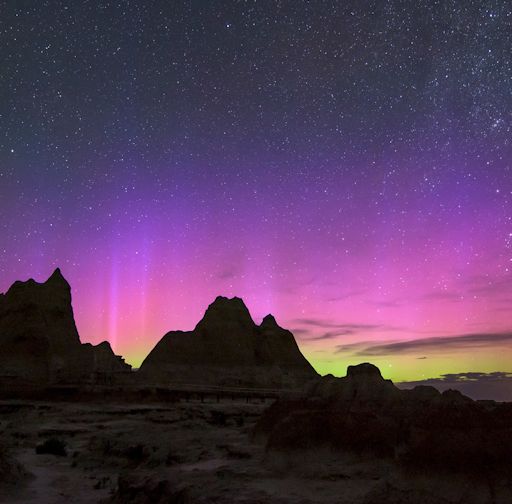Learn to photograph Northern Lights like a pro. Sign up for Peter Rosen's Aurora Photo Courses in Abisko National Park, winner of the TripAdvisor Certificate of Excellence Award 2015. | | |
(ALMOST NO) CHANCE OF FLARES: Solar activity is very low. With no sunspots actively flaring, the sun's X-ray output has flatlined. NOAA forecasters estimate a 10% chance of M-class solar flares and a miniscule 1% chance of X-flares on July 12th. Aurora alerts: text or voice.
THE FARSIDE OF PLUTO: Pluto has two sides: the nearside that New Horizons will see when it buzzes the dwarf planet on July 14th, and the farside that it won't. New Horizons just took the best picture it will ever take of Pluto's farside from a distance of 2.5 million miles:

Alan Stern, New Horizons principal investigator at the Southwest Research Institute in Boulder, Colorado, describes this image as "the last, best look that anyone will have of Pluto's farside for decades to come."
Of particular interest on the farside are four dark spots connected to a dark belt that circles Pluto's equatorial region. What continues to pique the interest of scientists is their similar size and even spacing. "It's weird that they're spaced so regularly," says New Horizons program scientist Curt Niebur at NASA Headquarters. Jeff Moore of NASA's Ames Research Center is equally intrigued: "We can't tell whether they're plateaus or plains, or whether they're brightness variations on a completely smooth surface." The spots appear on the side of Pluto that always faces its largest moon, Charon.
No one knows what these spots are, but there is hope for a solution to the mystery: "When we combine images like this of the farside with composition and color data the spacecraft has already acquired but not yet sent to Earth, we expect to be able to read the history of this face of Pluto," says Moore.
When New Horizons makes its closest approach to Pluto in just two days, it will focus on the nearside of the dwarf planet. On the morning of July 14, New Horizons will pass about 7,800 miles (12,500 kilometers) from the face with a large heart-shaped feature that's captured the imagination of people around the world.
Realtime Pluto Photo Gallery
SPACE WEATHER FORECAST FOR PLUTO: Forcasting space weather in the immediate vicinity of Earth is challenging. Forecasting space weather 3 billion miles away at the edge of the known solar system is almost impossible. Nevertheless, researchers at the Goddard Space Flight Center may have done it. Using a supercomputer model named "Enlil", they have tracked the motions of solar storms since January 2015 to predict conditions around Pluto in mid-July. Watch the movie, then read more about their predictions below:

"We set the simulation to start in January of 2015, because the particles passing Pluto in July 2015 took some six months to make the journey from the sun," says Dusan Odstricil of Goddard, who created the Enlil computer code in the 1990s. "During that time there were 120 separate CMEs."
"Our simulation estimates that during the New Horizon approach, Pluto might be immersed in a region with very low solar wind densities, lasting for about one month," says Odstricil. "This will be followed by a large merged region, which could significantly compress Pluto's atmosphere."
This one of the first space weather forecasts ever attempted so far from Earth. Needless to say, it is unlikely to be a perfect reflection of reality. Odstricil says his model could be off by two to three weeks. However, comparing the models with actual measurements from New Horizons will help make far-out space weather forecasts more accurate in the future.
Realtime Space Weather Photo Gallery
GEOMAGNETIC STORM: As predicted, a minor G1-class geomagnetic storm broke out during the late hours of July 10th when a high-speed solar wind stream hit Earth's magnetic field. "Aurora and pillars were visible to the naked eye, becoming bright at times," reports Randy Halverson from South Dakota's Badlands National Park. This is what he saw:

Auroras were also sighted above Vermont, Massachusetts, North Dakota, Wisconsin, Maine, and Michigan, and in eastern parts of Canada.
The storm is subsiding now. NOAA forecasters estimate a 50% chance that it could flare up again on July 12th as the solar wind continues to blow. Aurora alerts: text or voice.
Realtime Aurora Photo Gallery
Realtime NLC Photo Gallery
Realtime Sprite Photo Gallery
Every night, a network of NASA all-sky cameras scans the skies above the United States for meteoritic fireballs. Automated software maintained by NASA's Meteoroid Environment Office calculates their orbits, velocity, penetration depth in Earth's atmosphere and many other characteristics. Daily results are presented here on Spaceweather.com.
On Jul. 12, 2015, the network reported 14 fireballs.
(12 sporadics, 1 theta Perseid, 1 July Pegasid)

In this diagram of the inner solar system, all of the fireball orbits intersect at a single point--Earth. The orbits are color-coded by velocity, from slow (red) to fast (blue). [Larger image] [movies]
Potentially Hazardous Asteroids (
PHAs) are space rocks larger than approximately 100m that can come closer to Earth than 0.05 AU. None of the known PHAs is on a collision course with our planet, although astronomers are finding
new ones all the time.
On July 12, 2015 there were potentially hazardous asteroids.
Notes: LD means "Lunar Distance." 1 LD = 384,401 km, the distance between Earth and the Moon. 1 LD also equals 0.00256 AU. MAG is the visual magnitude of the asteroid on the date of closest approach. | | The official U.S. government space weather bureau |
| | The first place to look for information about sundogs, pillars, rainbows and related phenomena. |
| | Researchers call it a "Hubble for the sun." SDO is the most advanced solar observatory ever. |
| | 3D views of the sun from NASA's Solar and Terrestrial Relations Observatory |
| | Realtime and archival images of the Sun from SOHO. |
| | from the NOAA Space Environment Center |
| | the underlying science of space weather |
| | Web-based high school science course with free enrollment |

